1960s
I Dreamt I Saw Khrushchev (in a Pink Cadillac)
Posted By: Paul - Mon Jul 15, 2019 -
Comments (1)
Category: Humor, Music, Politics, 1960s, Russia, Cacophony, Dissonance, White Noise and Other Sonic Assaults
Sebastian Cabot’s “Like A Rolling Stone”
Posted By: Paul - Thu Jul 11, 2019 -
Comments (0)
Category: Ineptness, Crudity, Talentlessness, Kitsch, and Bad Art, Music, 1960s, Cacophony, Dissonance, White Noise and Other Sonic Assaults
Colgate Kitchen Entrees
One of the classic brand-extension blunders of all time has to be when toothpaste-maker Colgate decided to come out with a line of frozen dinners. The story is told in many places, and it's usually described as having occurred in 1982. For instance, here's the HuffPost's take on it:Lots of other sites refer to this as having happened in 1982, such as here, here, and here. But when I took a closer look at the story I couldn't find any primary sources from 1982 about it. But there are several 1960s-era sources (Washington Food Report, Weekly Digest) that refer to Colgate having test-marketed a line of frozen dinners in Madison, Wisconsin in 1964. A 1966 article in Television Age magazine offered some insight into what inspired the company to do this:
So, unless someone can find some primary sources that indicate otherwise, I'm going to assume that the Colgate Kitchen debacle actually happened in 1964, not 1982. And it was only a test-marketing trial run, not a full product roll-out. It would definitely be bizarre if, after the 1964 failure, Colgate tried the same thing again in 1982.
There's a couple of images of Colgate Kitchen entrees floating around the Internet, but I think they're all photoshops or mock-ups. For instance, the one below is a recent mock-up created by the Museum of Failure in Sweden.
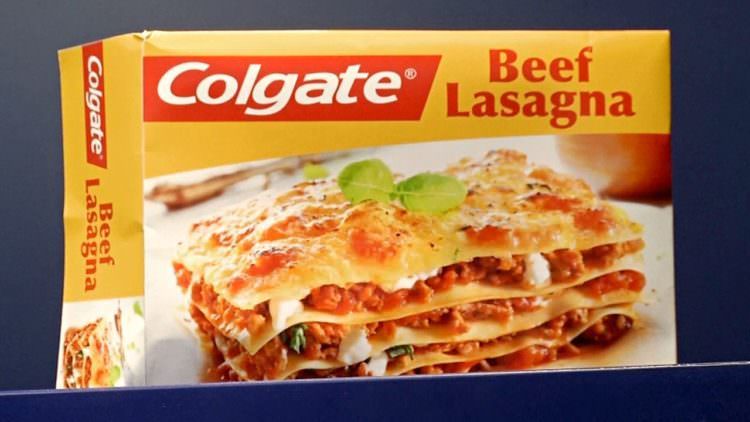
Posted By: Alex - Mon Jul 08, 2019 -
Comments (9)
Category: Business, Products, 1960s
The Rockin’ Ramrods, “Don’t Fool With Fu Manchu”
Posted By: Paul - Sun Jul 07, 2019 -
Comments (1)
Category: Literature, Mad Scientists, Evil Geniuses, Insane Villains, Music, 1960s
How to housebreak your dog
Ernie Bushmiller is best known as the creator of the Nancy comic strip, which was known for being very wholesome. But it turns out that his most popular and frequently reproduced cartoon, by a wide margin, was a slightly off-color one that he drew in 1961, and which was included that year in the Duch Treat Club Yearbook. He titled it "How to housebreak your dog."The Comics Journal details the many lives of this cartoon, noting:
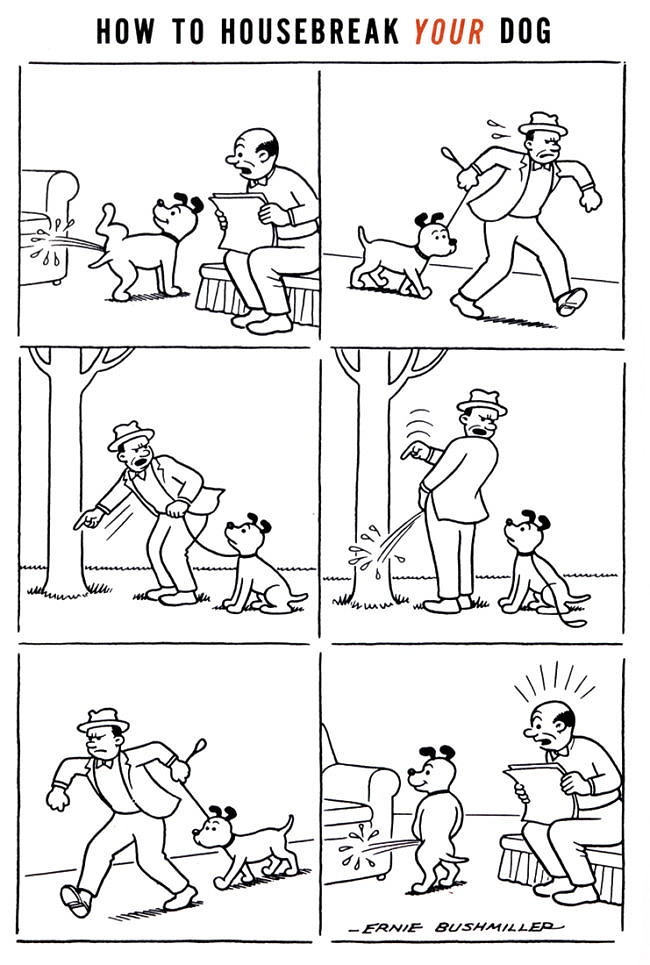
Posted By: Alex - Sat Jul 06, 2019 -
Comments (3)
Category: Comics, Dogs, 1960s
The Man Called Flintstone
Fred Flintstone as James Bond. Nuff said!The Wikipedia page.
Posted By: Paul - Fri Jul 05, 2019 -
Comments (0)
Category: Spies and Secret Agents, Homages, Pastiches, Tributes and Borrowings, Cartoons, 1960s
B. Prosperous
Continuing our ongoing theme of strange corporate mascots:From 1960-1962, B. Prosperous was the mascot of the Eastern Trust Company. He demonstrates a popular trend among mid-twentieth-century mascot creators, which was to slap a human head and limbs onto some inanimate object and call it a mascot.

Montreal Gazette - Mar 22, 1961
Posted By: Alex - Tue Jul 02, 2019 -
Comments (2)
Category: Corporate Mascots, Icons and Spokesbeings, 1960s
Bimbo Jr., the water-skiing elephant
Bimbo Jr. wasn't the only water-skiing elephant around, but in the early 1960s she gained some fame as the youngest water-skiing elephant. She was 5 at the time.However, her career as a water-skiier eventually came to an unusual end. In 1969, a car collided with the trailer that was transporting her. She survived, but her owner, Ted De Wayne, claimed that the experience caused her to forget how to water-ski, so he sued the driver for $10,000. He was awarded $4,500.
It's been reported in various places that the case was heard by Judge Turtle. But this isn't true. The judge's actual name was Julius Title.
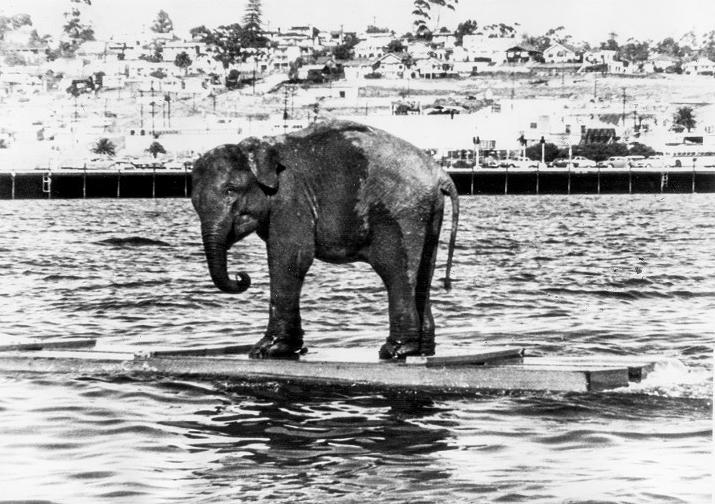
Bimbo water-skiing in San Diego - Mar 20, 1961.
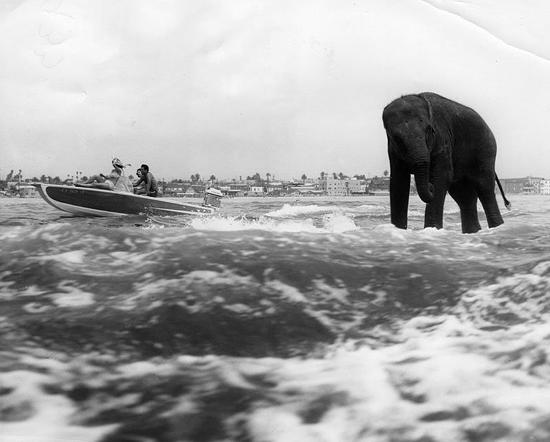
Bimbo water-skiing in Santa Monica - Apr 28, 1962 (via LA Public Library)
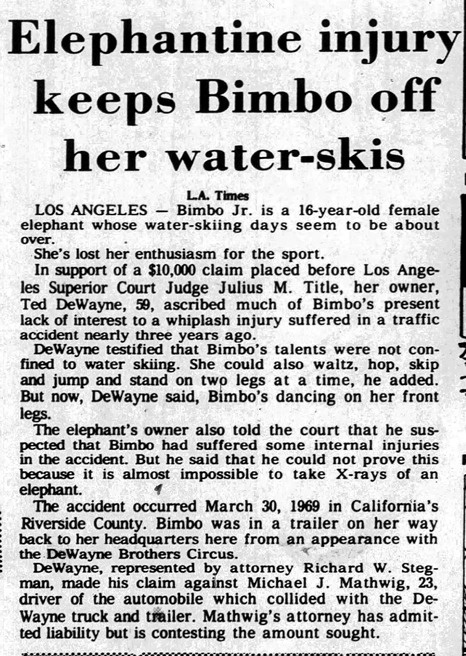
Salem Capital Journal - Feb 26, 1972
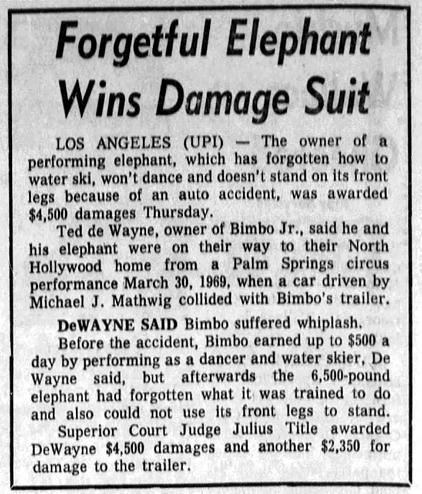
Orlando Evening Star - Feb 25, 1972
Posted By: Alex - Mon Jul 01, 2019 -
Comments (3)
Category: Animals, 1960s
Calvin and the Colonel
From the Wikipedia entry:
"The series was an animated remake of Amos 'n' Andy... and featured the voices of Freeman Gosden and Charles Correll[1] from the radio series (in fact, several of the original radio scripts by Joe Connelly & Bob Mosher were adapted for this series). Using animals avoided the touchy racial issues which had led to the downfall of Amos 'n' Andy."
Posted By: Paul - Tue Jun 18, 2019 -
Comments (0)
Category: Animals, Anthropomorphism, Racism, Stereotypes and Cliches, Television, Cartoons, 1960s
Skin Tight, Pin Striped, Purple Pedal Pushers
Posted By: Paul - Sat Jun 15, 2019 -
Comments (1)
Category: Fashion, Music, Public Indecency, 1960s

| Who We Are |
|---|
| Alex Boese Alex is the creator and curator of the Museum of Hoaxes. He's also the author of various weird, non-fiction, science-themed books such as Elephants on Acid and Psychedelic Apes. Paul Di Filippo Paul has been paid to put weird ideas into fictional form for over thirty years, in his career as a noted science fiction writer. He has recently begun blogging on many curious topics with three fellow writers at The Inferior 4+1. Contact Us |




